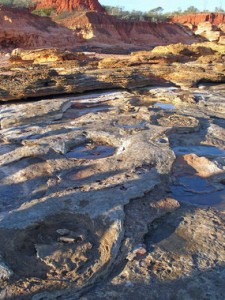Resources and a call from respected scientist to protect the James Price Point and Dampier peninsula dinosaur tracks.
Resource 1: A Letter by Dr Steven Salisbury, University of Queensland
Resource 2: Links to articles and further reading on the subject
1: Future of dinosaur tracks in the west Kimberley, Western Australia The coastline of the Dampier Peninsula north of Broome in the west Kimberley preserves one the largest and most significant stretches of dinosaur footprints anywhere in the world. The dinosaur tracks occur in coastal exposure of the 130 million year old Broome Sandstone, over 80 km of coastline from Broome to Cape Leveque. There are literally thousands of tracks representing as many as 15 different types of dinosaurs, some of which there is no other record for in Australia. With the exception of a few fragments of bone, these tracks constitute the entire fossil record of dinosaurs in the western half of the Australian continent. Some of the sauropod tracks are up to 1.5m long, and belong to what may have been some of the largest animals to have ever walked the planet (Thulborn et al. 1994; Thulborn 2009). The Kimberley dinosaur tracks are an important part of Australia’s geological heritage, and should be included in the proposed National Heritage listing for the west Kimberley. A final decision on National Heritage listing for the west Kimberley is due before the end of the June 2011.
In 2008, the State Government of Western Australia announced a proposal to exploit natural gas resources of the Browse Basin by installing a pipe-line and gas-processing plant in the region of James Price Point, on the western coast of the Dampier Peninsula. A large number of petroleum companies hold interests in the many gas fields of the Browse Basin. These include Woodside, BP, Chevron, BHP Billiton and Shell. Dinosaur prints at James Price Point will be destroyed if the proposed LNG plant is allowed to go ahead (Siversson 2010). In addition, sand-dredging of channels and the construction of groynes, bulkheads and breakwater structures associated with the LNG plant will result in the re-distribution of sand by longshore currents, which may further impact on dinosaur tracks on other parts of the Dampier Peninsula coastline.
A decision by the Federal Minister for the Environment Tony Burke on the inclusion of the dinosaur tracks in a proposed National Heritage listing for the west Kimberley is now imminent, as is environment approval for the oil and gas industrial site at James Price Point to service the off-shore resources of the Browse Basin. It is imperative that we voice our concern about this situation, and put pressure on the State Government of Western Australia, the Federal Government of Australia, and all or any of their corporate industrial partners who may be engaged in exploiting mineral resources of the Browse Basin.
I urge you to write to Tony Burke and express your concern about the future of the track sites. It is important to realize that National Heritage listing and environmental approval for the LNG gas hub are separate issues. National Heritage listing does not necessarily mean that the LNG gas hub will not go ahead. However, it does affect the decision making process and can potentially mitigate the effects of any development should it proceed.
We need Tony Burke to:
Ensure that the dinosaur tracks in the Broome Sandstone on the Dampier Peninsula north of Broome are included in the proposed National Heritage listing for the west Kimberley;
Refuse environment approval for an oil and gas industrial site at James Price Point.
Address your letter to:
The Hon Tony Burke MP
Minister for the Environment
PO Box 6022
House of Representatives
Parliament House
Canberra ACT 2600
email: Tony.burke.mp@aph.gov.au <mailto:Tony.burke.mp@aph.gov.au>
2: Further reading and links
ABC World Today
http://www.abc.net.au/worldtoday/content/2011/s3208592.htm
The Kimberley dinosaur tracks are an important part of Australia’s geological heritage, and should be included in the proposed National Heritage listing for the west Kimberley. A final decision on National Heritage listing for the west Kimberley is due before the end of the June 2011.
In 2008, the State Government of Western Australia announced a proposal to exploit natural gas resources of the Browse Basin by installing a pipe-line and gas-processing plant in the region of James Price Point, on the western coast of the Dampier Peninsula. A large number of petroleum companies hold interests in the many gas fields of the Browse Basin. These include Woodside, BP, Chevron, BHP Billiton and Shell. Dinosaur prints at James Price Point will be destroyed if the proposed LNG plant is allowed to go ahead (Siversson 2010). In addition, sand-dredging of channels and the construction of groynes, bulkheads and breakwater structures associated with the LNG plant will result in the re-distribution of sand by longshore currents, which may further impact on dinosaur tracks on other parts of the Dampier Peninsula coastline.
A decision by the Federal Minister for the Environment Tony Burke on the inclusion of the dinosaur tracks in a proposed National Heritage listing for the west Kimberley is now imminent, as is environment approval for the oil and gas industrial site at James Price Point to service the off-shore resources of the Browse Basin. It is imperative that we voice our concern about this situation, and put pressure on the State Government of Western Australia, the Federal Government of Australia, and all or any of their corporate industrial partners who may be engaged in exploiting mineral resources of the Browse Basin.
I urge you to write to Tony Burke and express your concern about the future of the track sites. It is important to realize that National Heritage listing and environmental approval for the LNG gas hub are separate issues. National Heritage listing does not necessarily mean that the LNG gas hub will not go ahead. However, it does affect the decision making process and can potentially mitigate the effects of any development should it proceed.
We need Tony Burke to:
Ensure that the dinosaur tracks in the Broome Sandstone on the Dampier Peninsula north of Broome are included in the proposed National Heritage listing for the west Kimberley;
Refuse environment approval for an oil and gas industrial site at James Price Point.
Address your letter to:
The Hon Tony Burke MP
Minister for the Environment
PO Box 6022
House of Representatives
Parliament House
Canberra ACT 2600
email: Tony.burke.mp@aph.gov.au <mailto:Tony.burke.mp@aph.gov.au>
2: Further reading and links
ABC World Today
http://www.abc.net.au/worldtoday/content/2011/s3208592.htm
The West Australian February 15, 2011, 11:17 am
Gas hub ‘would destroy dinosaur prints’ FLIP PRIOR. Dinosaur “underprints” at James Price Point would be destroyed if the proposed gas processing precinct went ahead, according to a new State Government report. http://au.news.yahoo.com/thewest/a/-/wa/8840878/gas-hub-would-destroy-dinosaur-prints/
National Heritage Council:
http://www.environment.gov.au/heritage/ahc/national-assessments/kimberley/index.html
Environmental Protection Authority, West Australian Government, Browse LNG Precinct Consultation Portal:
http://public-consult.epa.wa.gov.au/portal/browse-lng/
ABC Kimberley: http://www.abc.net.au/local/stories/2010/09/02/3000398.htm?site=kimberley?site=kimberley&ref=fb-top3-kimberley-regional-landing
References
Siversson, M. 2010. Preliminary Report upon the Palaeontology (including Dinosaur Footprints) of the Broome Sandstone in the James Price Point Area, Western Australia. Document 60103995-0000-GE-REP-0009, Browse LNG SEA, prepared for the Department of State Development by AECOM Australia Pty Ltd. January 2010, 14 pp.
Thulborn, T. 2009. Dinosaur Tracks of the Broome Sandstone, Dampier Peninsula, Western Australia – interim review. A report prepared for the Kimberley National Heritage Assessment, Natural & Indigenous Heritage Branch, Australian Federal Department of the Environment, Water, Heritage & the Arts. November 2009, 25 pp.
Thulborn, T., T. Hamley, and P. Foulkes. 1994. Preliminary report on sauropod dinosaur tracks in the Broome Sandstone (Lower Cretaceous) of Western Australia. Gaia 10: 85-94.








